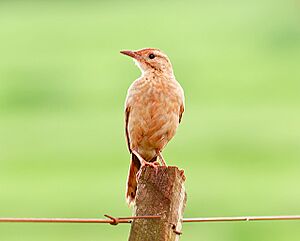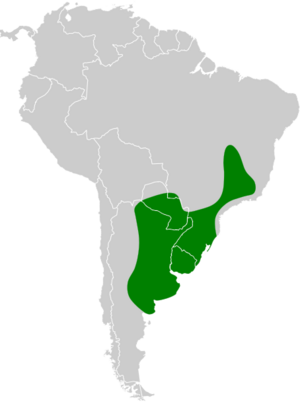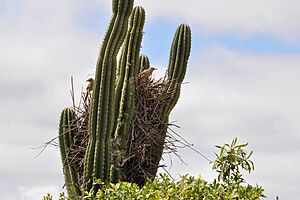Firewood-gatherer facts for kids
Quick facts for kids Firewood-gatherer |
|
|---|---|
 |
|
| Conservation status | |
| Scientific classification | |
| Genus: |
Anumbius
|
| Species: |
annumbi
|
 |
|
The firewood-gatherer (Anumbius annumbi) is a special type of bird that belongs to the ovenbird family called Furnariidae. You can find this bird in countries like Argentina, Brazil, Paraguay, and Uruguay.
Contents
About the Firewood-Gatherer
The firewood-gatherer is a unique bird. It's the only species in its group, meaning there are no different kinds of firewood-gatherers. It's also closely related to another bird called the lark-like brushrunner.
What Does It Look Like?
This bird is about 18 to 20 centimeters (7 to 8 inches) long. It weighs between 27 and 45 grams (about 1 to 1.6 ounces). Both male and female firewood-gatherers look the same.
They have a wide, whitish stripe above their eye. Their face is light brownish or grayish-brown. The top of their head is dull brown, and their back is dull brown too. They have narrow, dark streaks on their head and back. Their wings are mostly dull brown.
The central feathers of their tail are dark brownish and pointed. The other tail feathers are blackish-brown with some white tips. Their throat is white with small black spots on the sides. Their chest is a light reddish-brown, fading to a pale, buffy color on their belly.
Their eyes are brown or reddish. Their beak is dull brownish on top and gray on the bottom. Their legs and feet are gray or greenish-gray. Young birds look a bit different, with a more yellowish throat and less clear streaks on their upper parts.
Where Does It Live?
The firewood-gatherer lives in many open areas. These include grasslands, farms, savannas, and scrublands. You can also find them at the edges of open forests and near farmhouses. They live from sea level up to about 1,000 meters (3,300 feet) high.
In Brazil, they live from Goiás and Minas Gerais south to Rio Grande do Sul. They are also found in central and eastern Paraguay, almost all of Uruguay, and northern Argentina.
Firewood-Gatherer Behavior
Staying in One Place
These birds do not migrate. They stay in the same area all year long.
What Do They Eat?
Firewood-gatherers eat insects, spiders, and seeds. They usually look for food in pairs. Sometimes, they even forage in small groups that might include young birds helping out. They find their food on the ground and in low plants.
Building a Home and Raising Young
Firewood-gatherers build their nests during the spring and summer, from September to February. They often have two groups of young birds in one season. The young birds from the first group sometimes help build the nest for the second group.
They build a very large nest for a bird their size. It's made from thorny twigs woven together into a cylinder. These nests can be up to 110 centimeters (43 inches) tall and 40 centimeters (16 inches) wide. Some nests are even twice this size!
The nest has an entrance hole near the top. This leads to a winding tunnel that goes to the nest chamber. The chamber is lined with soft materials like plant fibers and feathers.
They often place their nests in easy-to-see spots, like in a single tree, on a utility pole, or another open place. Nests are usually within 4 meters (13 feet) of the ground, but can be as high as 24 meters (79 feet). Sometimes, they reuse their old nests.
A female bird usually lays three to five eggs. The eggs hatch after about 16 days. The young birds are ready to leave the nest about 17 or 18 days after they hatch.
Their Songs and Calls
The firewood-gatherer has a unique song. One way to describe it is a "strong, very high series of 2-3 hurried, staccato notes, followed by a short, slightly descending rattle, like 'djip-djip-drrrr'." Another description is "a fast, rough, bubbly, accelerating, descending series of trilled notes ending with lower-pitched rattle, 'chit, chit, chit, che-che-che-che-ee-ee-ee-ee-eu'." Both birds in a pair often sing together. Their call sounds like a sharp 'stchick'.
Conservation Status
The IUCN (International Union for Conservation of Nature) says the firewood-gatherer is a bird of "Least Concern." This means it's not currently in danger of disappearing. It lives in a very large area, and its population seems to be growing. There are no major threats to this bird right now. It can handle some changes to its habitat, like moderate grazing by animals or human activities like clearing forests. In fact, it might even benefit from some deforestation.



